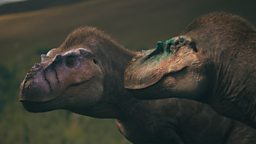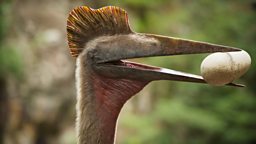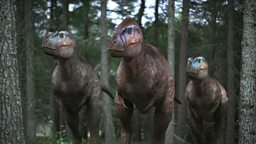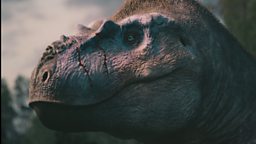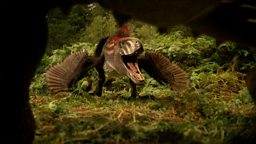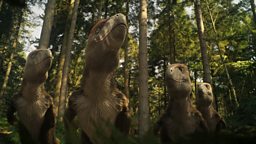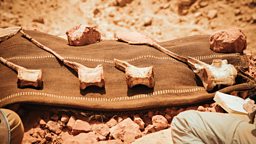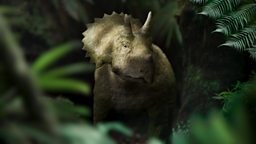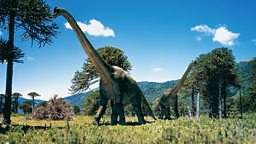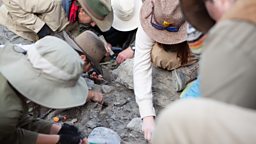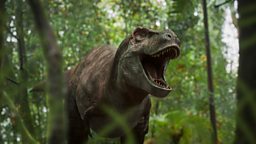The Evolution of Walking With Dinosaurs
By Thomas R. Holtz, Jr.
Dept. of Geology, University of Maryland, College Park, Maryland USA
Dept. of Paleobiology, National Museum of Natural History, Washington, DC USA

“I’m a palaeontologist myself; you can use the big words.” It was 1997 and I was on a trans-Atlantic phone call with Jo Wright, then a researcher for the ÃÛÑ¿´«Ã½. She had consulted with me about a proposed radical new documentary series about the life and times of the dinosaurs, and we were specifically discussing what different communities of ancient animals might be featured to help tell the story of dinosaur evolution.
This was the beginning of my association with the Walking With Dinosaurs project that has now continued for almost 30 years
This was the beginning of my association with the Walking With Dinosaurs project that has now continued for almost 30 years. In addition to serving as a subject expert for the original series, I also was featured onscreen for additional American content, and as a consultant on some of the sequel productions and the 2013 theatrical movie. So when I was once again asked to help out with the new incarnation of the show, I was excited to be part of this experience.
The last several decades has seen advancements both in the technology used to bring dinosaurs and other extinct animals to life on the screen and the science of knowledge about these creatures.

Experts in special effects and cinematography are better positioned to explain how the technical changes of rendering and animating dinosaurs have altered. From my point of view, some of the main updates in the technology was simply how the scientists, modellers, animators, and other production members could interact. In the late 1990s this had to be either in person (including a mini-conference held in London in which scientists and producers could collaborate on the appearance, motion, and behaviour of the various species) or via faxed drawings and email. By the time the theatrical movie was in production, our feedback could be more immediate: for instance, particular alternative model designs, animated walk cycles, and the like were placed on secure websites, and the scientists could view these and post our feedback. Now that synchronous streaming is so commonplace, we can have online meetings with each other and share video and drawings in real time.
our knowledge of dinosaurs and their world has greatly increased
During this same time, our knowledge of dinosaurs and their world has greatly increased. More than 1,000 species of Mesozoic dinosaur have been named in the 21st Century so far, essentially doubling the number known since the initial naming of Megalosaurus bucklandii in 1824 and the initial release of Walking With Dinosaurs. New analytical techniques—from isotopic and molecular studies through CT scans and bone histology to sophisticated biomechanical models (building on some of the same computational algorithms which the animators for Walking With Dinosaurs used)—have provided insights into dinosaur biology far beyond our capabilities in 1999.
And of course, the fossil discoveries themselves have provided us with new interpretations of the dinosaurs. The first discovery of fuzzy body coverings in dinosaurs other than birds was found just before the Walking With Dinosaurs project began, but now we find that fuzzy bodies, and even fully developed feathers identical to those of birds (the living part of the dinosaur family tree) were common in many groups. For instance, while Utahraptor was shown with a scaled body in 1999, the 2025 version is entirely cloaked in feathers: since 1999, every dromaeosaurid raptor (the group to which Utahraptor belongs) for whom the body covering has been found has shown that fully bird-like feathers were present.

But the most important part of the evolution of Walking With Dinosaurs over the past three decades has been that it has inspired and informed a generation about the wonderful science of ancient life. Many researchers at universities, museums, and other institutions around the planet recall how important watching Walking With Dinosaurs was in their youth. And millions more of the general public have stated that the original series or its sequels were their first encounter with dinosaurs shown as living, breathing animals rather than ravenous movie monsters.
it has inspired and informed a generation about the wonderful science of ancient life
May the new series continue to bring the wonder of the world of dinosaurs to people for years to come.
